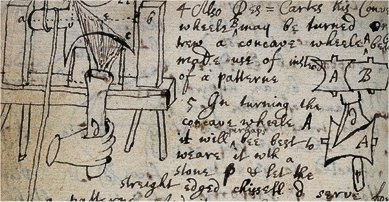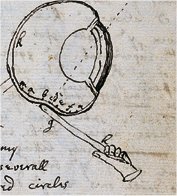|

Ms. Add. 4000 f. 26v
Shaping a wheel for the grinding of lenses
Notebook of 164 leaves (originally 166)
Newton appears to have begun using this notebook in the winter of 1663–4 and to have written in it extensively over the next two or three years. It contains notes on his mathematical and geometrical reading, drawn from van Schooten’s Exercitationum mathematicarum (Leiden, 1657) and from his edition of the works of Vičte (Leiden, 1646), as well as from the writings of the Oxford mathematician, John Wallis. Newton was particularly interested in Wallis’ Arithmetica infinitorum (included in his Opera mathematica of 1656–7), in which problems of mathematical methods of reasoning about the quadrature of areas and volumes through consideration of their indivisible elements of line and surface were set out. This notebook also contains evidence of the development of Newton’s own mathematical skill in this period, especially his study of infinite series and development of the binomial theorem, the evolution of the differential calculus, and its application to the problem of quadratures and integration. Although Newton had been inspired in his mathematical work on curved lines and surfaces by reading Wallis and by listening to the lectures that Barrow delivered in 1664, his knowledge of Descartes’ geometry was also critical in these discoveries.
One of the later entries in this notebook derives from Newton’s knowledge of Descartes’ La dioptrique, which Newton probably read in a Latin edition published at Paris in 1656. By September 1664, Newton had learned about the sine law of refraction through his reading of Descartes’ works, and, in the winter of 1665–6, he investigated Descartes’ findings about refraction at curved surfaces. This is probably the date of the composition of the essay ‘Of Refractions’, part of which is displayed here. Newton later told Oldenburg that he had first applied himself to grinding lenses that were not spherical in the winter of 1666 and this essay includes the detailed description of a machine for shaping a wheel to a hyperbolical profile, which could later be used for grinding lenses. Such a machine had been discussed in chapter ten of La dioptrique, but Newton improved the design and gave a geometrical demonstration of its operation. The final two leaves from Newton’s ‘Of Refractions’, which deal with compound lenses and the aberration of light refracted at a spherical surface, are missing from the notebook. They can now be found in the Macclesfield Collection, box 43.
Original on display in exhibition centre

Ms. Add. 3995 p. 15
Bound notebook of 174 leaves, paginated throughout.
An experiment to put pressure on the eye
Newton probably began making notes in this book in 1665 and 1666. The entries that he made then followed on both in subject matter and source material from some of the topics in his philosophical commonplace book (catalogue number 2). They fill the first twenty-two pages of this notebook, constituting an essay ‘Of Colours’ and are further broken down into 64 numbered sections or ‘experiments’ on pages 1 to 16. Newton’s observations in these sections move from the appearance of colour given off by different bodies, through experiments with prisms in which he determines that blue and red light appear to be refracted differently, to investigations of the ability to perceive colour and of the anatomy of the eye. In experiments 58 and 59, Newton writes
I tooke a bodkine gh & put it betwixt my eye & [the] bone as neare to [the] backside of my eye as I could: & pressing my eye [with the] end of it (soe as to make [the] curvature a, bcdef in my eye) there appeared severall white darke & coloured circles r, s, t, &c. Which circles were plainest when I continued to rub my eye [with the] point of [the] bodkine, but if I held my eye & [the] bodkin still, though I continued to presse my eye [with] it yet [the] circles would grow faint & often disappeare untill I removed [them] by moving my eye or [the] bodkin.
If [the] experiment were done in a light roome so [that] though my eyes were shut some light would get through their lidds There appeared a greate broade blewish darke circle outmost (as ts), & [within] that another light spot srs whose colour was much like [that] in [the] rest of [the] eye as at k. Within [which] spot appeared still another blew spot r espetially if I pressed my eye hard & [with] a small pointed bodkin. & outmost at vt appeared a verge of light.
This account is illustrated with the diagram displayed here. Newton’s interest in performing these experiments, however, was not confined to making optical or anatomical discoveries. As the entries in his earlier philosophical commonplace book indicate, Newton was also concerned with the way in which apparent sensations might in fact be the product of imagination and with the question of whether what one saw might be controlled by the nerves, and thus perhaps by the soul itself, rather than by some mechanical process of experience. These were issues that bothered both Descartes and Robert Boyle, on whose work on colour Newton was building, and some of the leading thinkers of contemporary Cambridge, in particular Henry More (1614–1687). More had also grown up in Grantham and had been one of the first English converts to Cartesianism before he became suspicious that Descartes’ mechanical philosophy left too little role for the activities of spirits and the soul. Newton’s experiments with his own eyes, as well as his investigation of the anatomy both of the human eye (which follows experiment 64 in this manuscript) and of a sheep’s eye, need to be interpreted in this context.
One of the entries in Newton’s philosophical commonplace book describes another experiment similar to that in the essay ‘Of Colours’, which is illustrated here as figure 9. Newton had been considering the question of whether the porosity of bodies may have some effect on the colours that they give off, perhaps by hindering the motion of rays of light. To investigate this, Newton experimented with the effects of putting pressure on his own eyeball:
If I presse my eye on [the] left side (when I looke towards my right hand) as at a, [then] I see a circle of red as at c but [within the] red is blew for [the] capillamenta are more pressed at n & o & round about [the] finger [than] at a towards [the] midst of [the] finger. [That parte] of [the apparition] at q is more languid because [the] capillamenta at o are duller & if [the] finger move towards e two much it vanisheth at q & appeareth semicircular. but if I put my finger at e or s [the] apparition wholly vanisheth. By putting a brasse plate betwixt my eye & [the] bone nigher to [the] midst of [the] tunica retina [than] I could put my finger I [made] a very vivid impression. But of an ellipticall figure because [the] edge of [the] plate [with which]
I prest my eye was long & not round like my finger
Newton also described an experiment involving looking at the sun and then at a piece of white paper. He claimed that he could replicate what he saw subsequently by imagining that he had looked at the sun ‘whence I gather that my fantasy and the Sun had the same operation upon the spirits in my optic nerve’
Although these investigations perhaps seem hazardous to us, Newton was far from being the only one of his contemporaries to regard his own body as a suitable object for experiment. His reports of his experiences retain throughout a detachment which appears clinical, yet in fact these were potentially some of the most moving as well as the most painful experiments that the young Newton could have performed. This was because the demonstration of how active spirits or the soul might affect perception could also be a powerful weapon against materialism and its bed-fellow, atheism.
After writing his essay ‘Of Colours’ and then making notes from various works of Robert Boyle, particularly New Experiments and Observations touching Cold (1665) and The Origine of Formes and Qualities (1666), Newton may have abandoned this notebook for a year or two. However, the interest in the shaping and ordering of matter that is apparent both in the notes that Newton took from Boyle and in his own experiments on colours, resurfaced shortly afterwards in entries based on fresh reading in the literature of alchemy. Initially, many of these were also drawn from Boyle, including some references to the work of Joan Baptista van Helmont, but they soon contained evidence of Newton’s assimilation of the writings of the mid-seventeenth-century alchemist, George Starkey (also known as Eirenaeus Philalethes). Although many of Newton’s notes were simply references to his reading, it is often clear that he was also recording his own attempts to reproduce the experiments that he was studying. This is especially apparent in the dated entries from the early and mid-1680s, by which time Newton’s library contained copies of all the works by Starkey to which he refers in this manuscript, but it is also suggested by notes that may have been made as early as 1669.

back to the top
|

